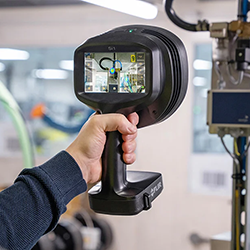Is RaaS the way to go?
Back in 2017, the International Data Corporation (IDC) predicted that 30 percent of commercial robotic applications will be in the form of Robots as a Service (RaaS) by 2019. Was this forecast accurate? Mark Howard, United States country manager of industrial parts supplier EU Automation, explains the current RaaS landscape in relation to these early projections.
RaaS is the idea of paying for a robot on a month-by-month, annual or project basis, rather than simply purchasing the physical robot outright. With RaaS, robots, software and maintenance are often bundled together and sold with a recurring subscription fee. Just like software as a service (SaaS) or machine as a service (MaaS), it’s the supplier’s responsibility to ensure the product is working effectively and is maintained over its lifespan. It’s the all-inclusive package deal many smaller businesses need.
RaaS starts with a service level agreement based on a business’s throughput. Because the business doesn’t buy the equipment, this is usually not a huge capital expense. Instead, the business simply pays for the expected output of the machine. Because of this, RaaS is a viable option in applications where robotic automation was previously too expensive.
It’s an easy sell — particularly for small to medium-sized businesses who haven’t previously dabbled in automation. No huge upfront investment, predictable costs and lower risk. So, how popular is this purchase model currently?
To date, two of the fastest growing industries taking full advantage of RaaS are healthcare and manufacturing. However, warehousing and order fulfilment are also seeing the appeal of RaaS to enhance their operational efficiency.
The current trends of RaaS continue to surround autonomous mobile robotics, such as automated guided vehicles (AGVs). These portable robots are usually used for transporting good through a facility, usually by following wires on the floor or using vision systems for navigation. While AGVs are the most popular, but that’s not to say we won’t see the same business model for the higher throughput industrial machines, such as SCARA, six-axis or Cartesian robots in the future.
One example of a business paving the way is Niryo, a manufacturer of a 3D-printed, six-axis robotic arm used by educators and researchers. This business is currently developing a new robot for small business owners using the RaaS model and is set to release further details this year.
For now though, most of the attention on RaaS models is focused on mobile service robots — think autonomous mobile carts, robotic forklifts and self-navigating drones.
Cost over confidence
One of the common criticisms of RaaS models is the cost. In the long run, will it cost more than buying a robot outright? Put simply, yes. Much like many other service models, those ‘cheaper’ recurring subscription costs will eventually catch up with the cost of buying a robot upfront.
That said, RaaS does provide small business owners with the confidence to experiment with robots, without breaking the bank on an upfront investment. What’s more, the return on investment (ROI) must also factor in the potential better service and convenience of a robot maintained by a third party.
Is RaaS practical?
Another criticism of RaaS is its practicality. Is it possible to build upon the concept of SaaS with hardware? SaaS was developed as the internet allowed instantly delivery, maintenance and updating of software. With hardware, there’s no such thing as instant maintenance. Can a robot manufacturer really provide a similar level of service, speed and vigilance to its RaaS customers that span the globe?
The emergence of cloud robotics will certainly have a positive impact on this criticism. The cloud provides easy access to programming and monitoring of the robot, even if the robot supplier is in a different country. That being said, remote access to the robot doesn’t solve the issue of mechanical fixes, should something physically go wrong.
With all that said, robots aren’t the only automation purchase a manufacturer makes. Long before the widespread use of robots, fundamental parts such as PLCs, HMIs and motors were already making their mark. Perhaps the RaaS hype, and the concerns over upfront capital expenditure, actually highlights a much wider issue of tight budgets and risk aversion across the entire industry.
RaaS is attractive because it’s easy on the wallet. The model allows users to sleep easy at night, knowing that if things do not go to plan, the robot can be handed back at the end of the contract.
Other parts within a facility could be covered by machines as a service (MaaS) options, but in reality, factory owners have aging and old parts that have either been discontinued or aren’t sexy enough to be offered under the new-age MaaS concept.
In fact, focusing on purchasing used, obsolete or reconditioned automation parts with a good warranty, could far surpass the potential cost savings of service models. Could the same be said for RaaS?
While IDC predicted the RaaS uptake of 2019, EU Automation predicts that many manufacturers will act sensibly, and take a holistic view before signing up to a RaaS contract. Service models will continue to introduce automation to smaller enterprises, but access to used, obsolete or discontinued automation parts will prove just as valuable to the industry.
About EU Automation: EU Automation stocks and sells new, used, refurbished and obsolete industrial automation spares. Its global network of preferred partner warehouses, and wholly owned distribution centers, enables it to offer a unique service within the automation industry, spanning the entire globe. It provides worldwide express delivery on all products meaning it can supply any part, to any destination, at very short notice.
Editors Recommendation "How Humans & Tech Harmonize in the Manufacturing Industry"
Comments (0)
This post does not have any comments. Be the first to leave a comment below.
Featured Product

